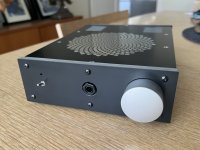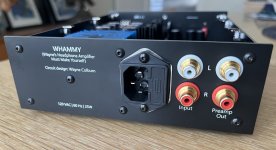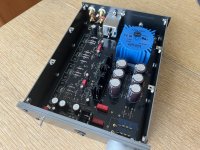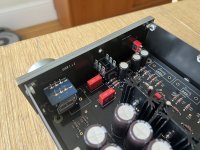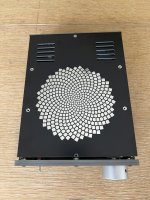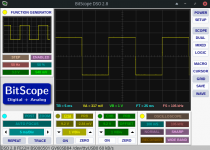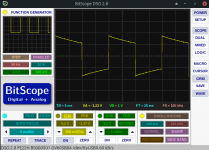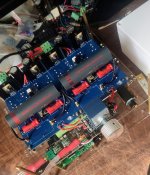It'd be better to place the additional reg PCB close to the OPAmp...protect whammy opamp from overvoltage:
The Whammy build procedure gives 3 options for 7815 output voltage -- 15v, 17v, or 22v. This does not bother the MOSFETs but it could damage an opamp where the absolute maximum supply voltage is exceded. I believe that the opamp supply should be fixed at 15v so that variations in 7815 MOSFET settings or transformers do not cause faults.
I modified the Whammy with 7815,7915 regulators just for the opamp. I installed a gridded PCB by drilling holes in the non-functional fins of the toroidal transformer. I lifted the hot side of R35 and R36 so that the opamp is powered by it's own regulators.
Be aware that the MOSFET regulators suffer more stress when a higher voltage toroid is used. This occurs because of the increased voltage across the linear regulators. Also, the vertical heatsinks on the main board are not very effective without a cooling fan.
I think the higher voltage after the regulators (+/-18V) is desirable for the MOSFETs and overall power output/drive capabilities. It is undesirable for the OPAmps... the JFET input ones (that would allow for DC sound path coupling. i.e. no capacitors) usually like to see no more than +/-12 ... maybe +/-15 V top.
If I were to make one of these kits, I'd add LT3054/LT3095 voltage regs to drop the rails down from +/-18V to +/-12V and then use my favourite OPAmp AD8066. That would be okay for the LT regs as well - they wouldn't need any heatsink due to a very low OPAmp current consumption.
Not to mention the very low noise environment established... for the OPAmp.
Last edited:
Hi C17 and C12 is decoupling capacitor ? I plan to upgrade sound by changing capacitor, but I did not know exactly what capacitor need to change.C13 gives you a comfortable feeling of reassurance and security, now that you have "bypassed" the two electrolytic capacitors in series, C17 and C12.
Leave C12, C17, as well as C22, C25 as stock.
If you want to experiment with capacitors, (and learn that they don't make anywhere near as much difference as many people believe…) change C1, C5.
If you want to experiment with capacitors, (and learn that they don't make anywhere near as much difference as many people believe…) change C1, C5.
Here's my (in progress) WHAMMY. I took the opportunity to design the enclosure in Fusion 360 to improve my skills. The top panel needs to be redone to fix an issue.
Attachments
Since the opamp has decoupling resistors and caps you could always put Zeners across the 220uF caps.
The 47 Ohm resistors may need to change but it could be done.
The 47 Ohm resistors may need to change but it could be done.
Thanks to this thread, I'm listening on my completed whammy. Here's a picture of the sloppy insides on final tests with a sacrificial pair of grados:

And a picture of my boring case, with a custom "knob" from a pal of mine ( @puck77 ->. https://www.diyaudio.com/community/threads/whammy-pass-diy-headphone-amp-guide.317803/post-6718478 )

And a picture of my boring case, with a custom "knob" from a pal of mine ( @puck77 ->. https://www.diyaudio.com/community/threads/whammy-pass-diy-headphone-amp-guide.317803/post-6718478 )
Hello vdupham,
nobody will be able to answer these two questions. Why? Because it depends on several factors.
The most important - listening taste.
More important in this design - the influence of the OPAmp.
But if you can get the Toshiba MosFets 2SK2013 / 2SJ313, then use them.
Between the ONSEMI / Fairchild FQP3N30 / FQP3P20 and the VISHAY IRF610PBF / IRF9610PBF
it is very difficult for me to hear a real audible difference. I think in a blind test I would fail.
I had the imagination, that the ONSEMI Fairchild have a slightly better?more? bass. But this is so marginal...
And the input caps (C1 and C5) are in my opinion much more important for the sound than the 22µF-caps (ELKOS). But this is my opinion.
The only way to find out. Solder caps in (that they are easy to desolder) - listen - decide what is best
for your ears.
Sorry that I can't offer a better answer! 🤔
Perhaps other WHAMMY-builders can chime in?
Cheers
Dirk 🙂
nobody will be able to answer these two questions. Why? Because it depends on several factors.
The most important - listening taste.
More important in this design - the influence of the OPAmp.
But if you can get the Toshiba MosFets 2SK2013 / 2SJ313, then use them.
Between the ONSEMI / Fairchild FQP3N30 / FQP3P20 and the VISHAY IRF610PBF / IRF9610PBF
it is very difficult for me to hear a real audible difference. I think in a blind test I would fail.
I had the imagination, that the ONSEMI Fairchild have a slightly better?more? bass. But this is so marginal...
And the input caps (C1 and C5) are in my opinion much more important for the sound than the 22µF-caps (ELKOS). But this is my opinion.
The only way to find out. Solder caps in (that they are easy to desolder) - listen - decide what is best
for your ears.
Sorry that I can't offer a better answer! 🤔
Perhaps other WHAMMY-builders can chime in?
Cheers
Dirk 🙂
If you have a scope and a square wave input to the Whammy C1 you can see (at U1-1) that the square wave input is no longer flat. I believe that C1 at 1uf needs to be increased so the bass is not rolled off at 50hz.Hello vdupham,
...
And the input caps (C1 and C5) are in my opinion much more important for the sound than the 22µF-caps (ELKOS). But this is my opinion.
The only way to find out. Solder caps in (that they are easy to desolder) - listen - decide what is best
for your ears.
Sorry that I can't offer a better answer! 🤔
Perhaps other WHAMMY-builders can chime in?
Cheers
Dirk 🙂
Attachments
Hi huge thanks to Pass Lab members and others to help me complete my build. I built my version Whammy, its mono version. I use IRF610/IRF9610 mosfet output and 2 single OPA445BM opamp. My headphone is Hifiman Sundara. Soundstage is outstanding, detail is so good with mature and neutral. And PSU part is LM317/LM337 with DC servo LF453, so zero noise or hum.
Attachments
Just to update this @ArtNova , I grabbed 8 different op amps from Mouser (from the super cheap NE5532P to the relatively expensive AD746JNZ) and have just started playing with them for a laugh. I don't have test equipment for them, and know they likely make very little if any audible difference, but my logic is just to swap one in, and try it until I get bored of it.Just the stock one for now, but I've mounted the caps either side underhung so that I can play with some big opamps if required (although that input cable might need to be rerouted if I do).
Here's the full compliment I now have to play with in order of expense:
RC4580 (stock - seemed fine)
NE5532P (a tech friend said to stop here, but clearly I didn't listen)
NJM4556AD
LM833N/NOPB
LM4562NA/NOPB
LME49720NA/NOPB (currently socketed - seems good)
OPA2134PA
OPA2228PA
AD746JNZ (felt it was a bit sharp - probs not worth the expense for audio)
That lot all together is still cheaper than the cheapest discrete, especially if you leave the last one off.
Today is Wayne's birthday.
Happy Birthday Wayne!

Happy Birthday Wayne!

It is notIf you have a scope and a square wave input to the Whammy C1 you can see (at U1-1) that the square wave input is no longer flat. I believe that C1 at 1uf needs to be increased so the bass is not rolled off at 50hz.
C1 =1uF into R3 = 100K = F-3dB at 1.6hz.
- Home
- Amplifiers
- Pass Labs
- "WHAMMY" Pass DIY headphone amp guide
